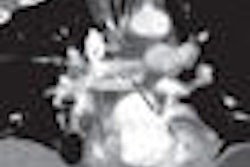A study that compared the risks and benefits of radiography and CT when evaluating patients with traumatic cervical spine injuries shows that the superior diagnostic accuracy of MDCT outweighs the modality's increased radiation risks.
Although radiography has been the standard method for evaluating cervical spine injuries, MDCT scanners allow multiplanar reconstruction of images, leading to increased diagnostic accuracy, according to an article published in the October issue of Medical Physics (October 2009, Vol. 36:10, pp. 4461-4469).
Researchers from the department of medical physics at the University of Crete noted that the traditional imaging approach of choice for cervical spine trauma has been plain radiography (three or five views), followed by CT as an adjunct. However, plain radiographs could potentially be eliminated from the diagnostic workup of C-spine trauma due to the wide availability of MDCT scanners, which offer more rapid and accurate clearance of trauma patients.
But MDCT's advantages need to be weighed against the modality's higher radiation burden compared to radiography -- especially in the current environment of heightened sensitivity regarding radiation dose. A research team led by Nicholas Theocharopoulos sought to determine if CT's higher radiation levels -- which could result in late radiation effects such as leukemia and solid cancers -- are justified compared to other modalities.
As its study cohort, the team created a computer model of 1 million hypothetical patients who received CT scans and radiography exams for cervical spine fractures. The effectiveness of the modalities were calculated for three different groups of patients, classified by risk (low, moderate, and high) as well as four different age groups (20, 40, 60, and 80 years old). Patients were also analyzed based on gender. The groups at risk for cervical spine fracture were incorporated in the decision model on the basis of hypothetical trauma mechanism and clinical findings.
Three imaging policies for working up C-spine trauma were considered: radiography alone, MDCT alone, and a combination of radiography followed by CT as an adjunct for positive findings. The researchers assumed that a positive diagnosis was followed by a surgical or nonsurgical intervention, and postoperative mortality was also accounted for.
To calculate radiation risk from the different approaches, the researchers used entrance surface dose (ESD) measurements. For radiography dose, they measured dose delivered to an anthropomorphic phantom in various positions with a commercially available radiography system (Polydoros 50, Siemens Healthcare, Erlangen, Germany). They found that the typical effective dose from a three-view radiography study of the cervical spine amounts to 0.05 mSv.
For CT dose, they performed an eight-month prospective study of patients already receiving CT scans for C-spine trauma at their institution using a 16-slice scanner (Somatom Sensation 16, Siemens), with a protocol of 120 kVp, pitch of 0.62, and slice reconstruction of 0.75 mm. They found that the radiation burden of a typical CT scan amounts to 3.8 mSv for male patients and 3.4 mSv for females.
The researchers then calculated lifetime attributable risk of mortal cancer from each of the three imaging approaches in the different patient cohorts using probability tables from the Biologic Effects of Ionizing Radiation (BEIR) VII report.
To determine the impact of each imaging strategy on outcomes, the group derived sensitivity and specificity ratings for radiography and CT based on the published literature. Sensitivity for CT ranged from 98% to 99% and for radiography from 25% to 93%. They said that specificity was 100% for CT, and for radiography it ranged from 99% to 100%.
They found that the use of CT in a hypothetical cohort of 1 million patients presenting for C-spine trauma prevents approximately 130 incidents of paralysis in the low-risk group, which had a fracture probability of 0.5%; 500 in the moderate-risk group, with a fracture probability of 2%; and 5,100 in the high-risk group, with a fracture probability of 20%.
The expense of this CT-based prevention is 15 to 32 additional radiogenic lethal cancer incidents per 1 million patients. This is in addition to any cancers that might be caused by plain radiography or radiography followed by CT for positive findings.
Theocharopoulos et al concluded that the use of CT alone is more favorable than the use of radiography alone or radiography with CT by calculating disability ratios, in which a higher number indicates an increased benefit for the CT-only approach. Disability ratios for radiography versus exclusively CT ranged from 13.3 for low-risk 20-year-old patients to 22.6 for high-risk 40-year-old patients. CT was slightly less advantageous for 80-year-old patients due to higher postoperative mortality.
The group also found that the combined radiography-followed-by-CT approach was only slightly more advantageous than radiography alone, and only for moderate- and high-risk patients.
"For the evaluation of CS trauma, the higher diagnostic accuracy obtained by the CT examination counterbalances the increase in dose compared to plain radiography or radiography followed by CT for positive findings and renders CT utilization dose effective and justified regardless of the patient age, sex, and fracture risk," the authors concluded.
By Donna Domino
AuntMinnie.com contributing writer
October 30, 2009
Related Reading
Incidental findings common after cervical spine CT for trauma evaluation, March 17, 2009
CT more sensitive than spinal fracture x-ray, but has limits, January 30, 2006
CT: An all-star modality for C-spine trauma? August 18, 2004
Studies and practice shape CT's role in c-spine trauma, August 28, 2001
Copyright © 2009 AuntMinnie.com




















